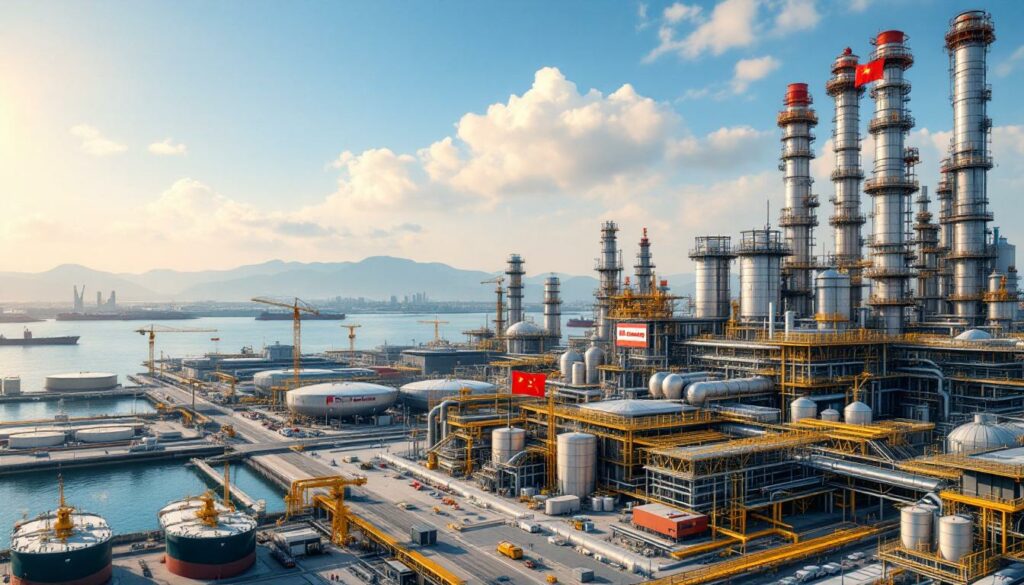PetroChina's $9.6 Billion Dalian Refinery Revamp: Strategic Implications and Market Impact
PetroChina, China's largest oil and gas producer, has officially approved a massive $9.6 billion investment to upgrade its Dalian refinery complex. This strategic decision represents one of the company's most significant capital expenditures in recent years, highlighting the continued importance of refining infrastructure in China's energy landscape despite global energy transition pressures.
Located in northeastern China's Liaoning province, the Dalian facility has long served as a critical energy hub. The comprehensive overhaul aims to transform the aging complex into a world-class integrated refining and petrochemical operation capable of meeting growing domestic demand while enhancing China's competitive position in global markets.
What is the Dalian Refinery Revamp Project?
The Dalian refinery revamp represents PetroChina's commitment to modernizing its downstream operations amid changing global energy dynamics. The project involves a complete technological overhaul of existing facilities while significantly expanding capacity and capabilities.
At its core, the initiative will transform the Dalian complex from a conventional refinery primarily focused on transportation fuels into an integrated facility with advanced petrochemical production capabilities. This shift aligns with industry-wide trends toward higher-value chemical products that face less competition from renewable energy alternatives.
The revamp includes installation of state-of-the-art catalytic cracking units, hydroprocessing facilities, and dedicated petrochemical production trains. These upgrades will not only increase overall processing capacity but also enable the facility to produce a more diverse range of high-value products while meeting increasingly stringent environmental standards.
Strategic Location Advantages
The Dalian facility's coastal location provides significant strategic advantages that have influenced PetroChina's investment decision:
- Direct deep-water port access facilitates efficient crude oil imports and product exports
- Proximity to key Northeast Asian markets reduces transportation costs
- Integration with existing pipeline infrastructure connects to inland markets
- Position within Liaoning province's industrial cluster creates synergies with manufacturing sectors
Why is PetroChina Investing in Refinery Expansion Now?
Strategic Timing in Global Energy Markets
PetroChina's decision to proceed with this substantial investment comes at a pivotal moment in global energy markets. Several macroeconomic and industry-specific factors make this a strategically opportune time for refinery expansion:
- Supply chain resilience: The COVID-19 pandemic and subsequent geopolitical tensions have highlighted vulnerabilities in global supply chains, pushing China to strengthen domestic production capabilities
- Energy security imperatives: Amid global uncertainty, China continues prioritizing energy independence and security of supply
- Technology advancement cycle: The current generation of refining technologies offers significantly improved efficiency and product flexibility compared to equipment installed a decade ago
- Competitive positioning: Other regional refiners are undertaking similar modernization efforts, creating pressure to maintain market position
"This investment signals PetroChina's confidence in the long-term viability of petroleum products, particularly petrochemicals, despite the growing focus on energy transition. It represents a strategic hedging approach—diversifying toward chemical products that face less immediate competition from renewable alternatives," notes energy analyst Zhang Wei from the China Petroleum University.
Domestic Market Dynamics
Within China's domestic context, several market forces have converged to make this investment particularly timely:
- Manufacturing sector growth: China's expanding manufacturing base requires increased supplies of petrochemical feedstocks and specialized products
- Tightening environmental regulations: New emissions standards necessitate modernization of aging refinery infrastructure
- Regional economic revitalization: The project aligns with government initiatives to rejuvenate traditional industrial regions in northeastern China
- Evolving demand patterns: Chinese consumers increasingly demand higher-quality fuels and specialty chemicals
How Will the Dalian Refinery Transformation Impact Production?
Current vs. Future Capacity
The revamp will dramatically enhance both the scale and sophistication of operations at the Dalian facility. The project represents one of the most significant capacity expansions in Asia's refining sector:
| Parameter | Pre-Revamp Capacity | Post-Revamp Capacity | Percentage Increase |
|---|---|---|---|
| Crude Processing | 410,000 bpd | 600,000 bpd | 46% |
| Petrochemical Output | 1.2 million tonnes/year | 3.8 million tonnes/year | 217% |
| Ultra-low Sulfur Diesel | 120,000 bpd | 240,000 bpd | 100% |
| Aviation Fuel | 80,000 bpd | 140,000 bpd | 75% |
| Aromatics Complex | Limited capability | 1.6 million tonnes/year | N/A |
This expansion will place the Dalian facility among the largest integrated refining and petrochemical complexes in Asia, with particular emphasis on high-value chemical production.
Technological Enhancements
The $9.6 billion investment encompasses implementation of numerous advanced technologies that will transform the facility's capabilities:
- Residue hydrocracking units to maximize conversion of heavy fractions into valuable light products
- Integrated aromatics complex for production of benzene, toluene, and xylenes
- Advanced catalytic reforming with continuous catalyst regeneration
- Solvent deasphalting to improve feedstock quality for conversion units
- Energy recovery systems including cogeneration facilities
- Digital twin technology for real-time optimization and predictive maintenance
- Zero-liquid discharge water treatment to minimize environmental impact
These technological upgrades will not only improve product yields but also enhance energy efficiency, reducing the facility's carbon intensity per ton of product.
What Are the Economic Implications of the Project?
Investment Structure and Financing
The $9.6 billion investment represents a major capital commitment from PetroChina. The financing structure includes:
- Direct capital allocation from PetroChina's corporate investment budget
- Potential joint venture arrangements with technology providers
- Provincial economic development funding for associated infrastructure
- Possible green financing components for emissions reduction technologies
While substantial, this investment aligns with PetroChina's long-term capital expenditure strategy, which continues to balance upstream exploration with strategic downstream investments.
Economic Impact Assessment
The project is expected to generate substantial economic benefits across multiple dimensions:
- Direct employment: Creation of approximately 8,000 jobs during peak construction and 1,200 permanent positions
- Indirect employment: An estimated 5,000 additional jobs in supporting industries and services
- Local economic stimulus: $1.2-1.5 billion in procurement from local suppliers during construction
- Tax revenue: Projected $300-400 million annually in various taxes and fees
- Export potential: Enhanced capability to export high-specification products worth an estimated $1.8 billion annually
"Projects of this scale create ripple effects throughout the regional economy. Beyond direct employment, they establish long-term industrial ecosystems that support thousands of additional jobs across the supply chain," explains Dr. Liu Chen, economics professor at Northeast China Normal University.
The economic benefits extend beyond quantifiable metrics to include technology transfer, workforce skill development, and infrastructure improvements that enhance regional competitiveness.
How Does This Project Fit into China's Energy Strategy?
Alignment with National Energy Policies
The Dalian refinery revamp aligns with several key elements of China's evolving national energy strategy:
- Dual Circulation Strategy: Supporting both domestic consumption and export capabilities
- Manufacturing 2025 Initiative: Providing high-quality inputs for advanced manufacturing
- Carbon Peaking and Neutrality Goals: Implementing more efficient technologies while preparing for future transitions
- Energy Security Enhancement: Reducing vulnerability to supply disruptions or oil price movements
- Quality Over Quantity Growth: Focusing on higher-value products rather than simple volume expansion
This investment reflects China's pragmatic approach to energy transition—modernizing traditional energy infrastructure while simultaneously developing renewable alternatives.
Regional Development Considerations
Beyond national priorities, the project serves important regional development objectives:
- Northeast Revitalization Program: Supporting economic transformation in a region traditionally dominated by heavy industry
- Industrial Upgrading: Replacing outdated facilities with modern, efficient operations
- Skills Development: Creating opportunities for advanced technical training in a region facing demographic challenges
- Infrastructure Enhancement: Catalyzing improvements in supporting transportation and utility infrastructure
The project demonstrates how fossil fuel investments can be structured to support broader economic and social development goals during energy transition periods.
What Environmental Considerations Are Included in the Revamp?
Emissions Reduction Technologies
Despite being a fossil fuel facility, the modernization includes significant environmental upgrades designed to minimize ecological impact:
- Advanced sulfur recovery units capable of reducing SOx emissions by over 85%
- Selective catalytic reduction systems for NOx abatement
- Vapor recovery systems to capture volatile organic compounds
- Closed-loop cooling water systems to minimize water consumption
- Continuous emissions monitoring with real-time public reporting
- Flare gas recovery to reduce routine flaring by over 95%
- Energy efficiency measures projected to reduce CO₂ emissions by 18% per barrel processed
These technologies represent best available techniques for minimizing environmental impact from refining operations.
Regulatory Compliance and Beyond
The revamped facility is being designed to exceed current regulatory requirements:
- Compliance with China's ultralow emissions standards for industrial facilities
- Adherence to World Bank environmental guidelines for petroleum refining
- Preparation for anticipated future regulations through modular design
- Incorporation of carbon capture readiness in facility layout and equipment specifications
"Modern refineries can achieve dramatically lower emissions profiles than facilities built even a decade ago. The technologies exist to reduce traditional pollutants by 80-95% compared to older operations," notes environmental engineer Dr. Wang Mei from Tsinghua University's Institute of Environmental Sciences.
When Will the Dalian Refinery Revamp Be Completed?
Project Timeline and Milestones
The massive scale of this project necessitates a multi-year implementation plan:
- Engineering and Design Phase (2022-2024): Detailed engineering and technology selection
- Equipment Procurement (2024-2025): Ordering of long-lead items and specialized equipment
- Site Preparation (2025): Demolition of obsolete units and foundation work
- Major Construction (2025-2028): Installation of primary processing units
- Commissioning (2028-2029): Phased startup of new facilities
- Full Operations (2029-2030): Integrated operation of the complete complex
This phased approach allows for continued operation of portions of the existing facility during construction, minimizing supply disruptions.
Potential Challenges to Timeline
Several factors could influence the project schedule:
- Global supply chain constraints for specialized equipment and catalysts
- Technical integration challenges between existing and new systems
- Skilled labor availability in a region with demographic challenges
- Evolving regulatory requirements that might necessitate design modifications
- Market conditions potentially affecting investment pacing decisions
PetroChina has incorporated contingency periods into the timeline to accommodate these potential challenges.
How Does This Compare to Other Global Refinery Investments?
Comparative Scale Analysis
PetroChina's $9.6 billion investment ranks among the most significant current refinery projects globally:
| Project | Location | Investment Value | Capacity Addition | Completion Target |
|---|---|---|---|---|
| Dalian Refinery Revamp | China | $9.6 billion | 190,000 bpd | 2029 |
| Jamnagar Expansion | India | $10.1 billion | 400,000 bpd | 2026 |
| Al Zour Refinery | Kuwait | $16 billion | 615,000 bpd | Completed 2022 |
| Dangote Refinery | Nigeria | $19 billion | 650,000 bpd | Completed 2023 |
| Duqm Refinery | Oman | $8 billion | 230,000 bpd | 2026 |
What distinguishes the Dalian project is its emphasis on petrochemical integration rather than simply expanding fuel production capacity. This focus on higher-value products reflects a more sophisticated approach to refinery economics in a world facing potential peak fuel demand.
Strategic Positioning
Unlike many greenfield projects, the Dalian revamp focuses on:
- Modernizing existing infrastructure rather than building entirely new capacity
- Integrating refining with petrochemical production for higher value creation
- Optimizing for specific regional market needs rather than primarily export markets
- Incorporating flexibility to adapt to evolving demand patterns
- Leveraging existing logistics infrastructure and skilled workforce
This approach minimizes both capital requirements and environmental impact while maximizing economic returns.
What Market Impact Will the Dalian Refinery Revamp Have?
Domestic Market Effects
Within China, the expanded capacity will influence several market dynamics:
- Product Availability: Increased domestic supply of high-specification transportation fuels and petrochemicals
- Import Substitution: Reduction in imports of key petrochemicals valued at approximately $3-4 billion annually
- Price Competition: Potential downward pressure on domestic prices for certain products
- Quality Improvements: Acceleration of higher fuel standards nationwide
- Industry Consolidation: Potential pressure on smaller, less efficient refiners
The project reinforces the trend toward larger, more complex refining operations with integrated petrochemical production.
International Market Implications
The project will also have ripple effects in international markets:
- Reduced Import Demand: Decreased Chinese imports from regional refiners in South Korea, Japan, and Singapore
- Specialty Chemical Exports: Potential increased exports of high-value petrochemicals to regional markets
- Crude Oil Sourcing: Increased demand for medium-sour crude varieties most suited to the facility's configuration
- Regional Capacity Rationalization: Potential acceleration of closures of less competitive regional refineries
"The Dalian expansion represents part of a broader shift in global refining center of gravity toward Asia. As Western markets face potential demand declines, Asian facilities continue expanding to meet growing regional consumption," observes petrochemical market analyst David Rodriguez of Global Energy Consultants.
What Are the Investment Implications for the Energy Sector?
Industry Trend Indicators
PetroChina's massive investment signals several important trends for energy investors:
- Selective Downstream Investment: Major oil companies remain willing to invest in downstream assets with the right characteristics
- Petrochemical Integration: Vertical integration from refining to petrochemicals represents a key strategic direction
- Modernization Imperative: Willingness to invest in modernization rather than just maintenance of existing assets
- Energy Transition Hedging: Preparation for changing demand patterns through product flexibility
These trends suggest a nuanced approach to energy transition rather than wholesale abandonment of traditional business lines.
Competitive Positioning
The investment will strengthen PetroChina's position in several ways:
- Cost Leadership: Modern technologies typically offer 15-20% better operating economics than previous generation equipment
- Product Flexibility: Enhanced ability to adjust product slate based on market conditions and margin opportunities
- Environmental Compliance: Better positioning for future carbon pricing or emissions trading schemes
- Talent Attraction: State-of-the-art facilities better positioned to attract skilled technical workforce
For investors, the project demonstrates PetroChina's commitment to maintaining its leading position in China's downstream sector despite energy transition pressures, creating potential investment opportunities 2025 in the energy sector.
What Does This Mean for Global Oil Demand?
Consumption Implications
The expansion sends mixed signals about future oil demand:
- Near-Term Confidence: Indicates expectation of continued strong demand for petroleum products through the 2030s
- Long-Term Adaptation: Focus on petrochemicals suggests preparation for transportation fuel demand plateauing
- Strategic Diversification: Broader product slate provides options as energy transition progresses
- Technological Flexibility: Design accommodates potential future modifications for changing market conditions
This nuanced approach reflects the complex reality of energy transition—a gradual evolution rather than abrupt disruption, with OPEC market influence remaining significant throughout this period.
Feedstock Requirements
The expanded capacity will influence crude oil price trends and purchasing patterns:
- Increased Crude Imports: Additional crude oil imports of approximately 190,000 barrels per day
- Crude Quality Preferences: Enhanced configuration optimized for medium-sour crude varieties
- Supply Security Focus: Likely emphasis on diversified supply sources to minimize geopolitical risk
- Long-Term Contracting: Potential new term agreements with strategic suppliers to secure reliable feedstock
These requirements will provide support for specific grades of crude oil even as overall global demand patterns evolve, potentially counterbalancing the effects of US economy tariffs on international trade flows.
FAQs About PetroChina's Dalian Refinery Revamp
What products will the revamped Dalian refinery produce?
The upgraded facility will produce a diverse slate of products including transportation fuels (gasoline, diesel, jet fuel), lubricant base oils, and petrochemical feedstocks such as ethylene, propylene, aromatics (benzene, toluene
Ready to Spot the Next Major Mineral Discovery?
Discover why significant ASX mineral discoveries can lead to exceptional returns by exploring Discovery Alert's dedicated discoveries page, where our proprietary Discovery IQ model transforms complex mining data into actionable investment insights for traders and long-term investors alike.




